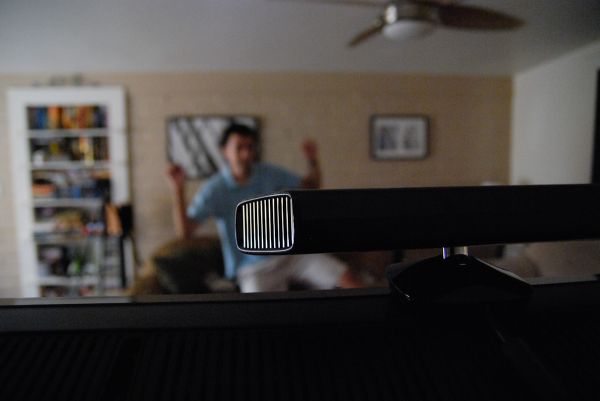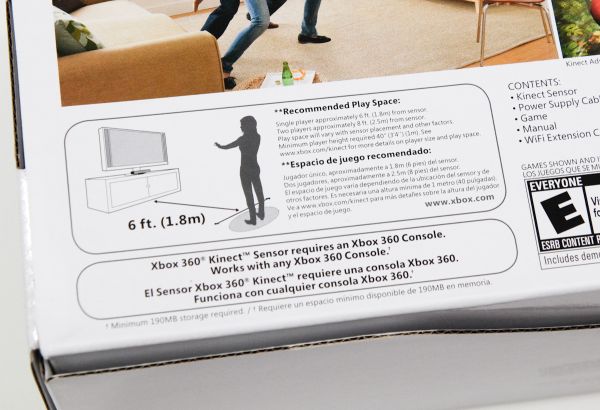Microsoft Kinect: The AnandTech Review
by Brian Klug on December 9, 2010 3:20 PM ESTKinect - Environmental Constraints
There are a lot of environmental constrains that the Kinect imposes, but the system actually works extremely well. Inside the manual and throughout the literature distributed with Kinect are notices about reducing ambient sunlight in the room you’re using the Kinect. At the same time, you need ambient light for the RGB color camera to work - this seems somewhat confusing until you consider that sunlight also contains spectral components at the same wavelength the Kinect operates at. Lots of ambient sunlight thus decreases the visibility of those spots on the room and players, and could conceivably make depth detection much worse. That sort of reminds me how the Wii sensor bar could be emulated with candles some distance apart atop the television, or how playing with the Wii next to a fireplace could easily make the system glitch out.
In practice, I never once noticed problems with depth detection on Kinect that I’d blame on ambient noise from stray light sources - even in a room with, yes, a huge fireplace (hey, it’s a reasonable test). The more important consideration actually turns out to be the relatively poor sensitivity of the RGB camera, which requires lots of room lighting to get decent framerate or augment facial detection.
The more important consideration for playing space is play space size - you need a big room to use Kinect. On the back of the Kinect packaging, Microsoft notes that a distance of 6’ from TV to players is requisite at minimum. After a lot of testing, I’d say 6’ is optimistic, even for one person. In actuality I’d say 9’-12’ is closer to what is optimal, especially if you want to play with a second person, and later inside games you’ll be told as much.
Sensor position itself makes a lot of difference here - Kinect can go either on top or below the TV, and Microsoft recommends anywhere 2’ - 6’ off the ground. Ultimately, the bar is that Kinect needs to be able to see your entire person - feet, head, and some distance around you to move, jump, and flail your arms around inside. If you place the Kinect on an entertainment center table below the TV, the hazard is that the depth of the table will block part of the depth image at the bottom. I had much more success with placing the Kinect atop TVs, especially when you encounter LCDs and pasmas of the wall-mounted sort.
The first area I tested was my living room, which is reasonably large (or so I used to think), and I played with about 7 feet away from the sensor. I moved a coffee table, unfortunately moving my couch is prohibitively difficult, and I didn’t have space to get rid of it. I was able to play with two people, but it was a bit cramped, and I felt like I needed more distance from the TV the whole time.
 See that above me? Yeah, it's a ceiling fan.
See that above me? Yeah, it's a ceiling fan.
The consideration I didn’t think of is what’s above. Needless to say, you need space to flail your arms around, especially if you’re tall. Above me within arm’s reach is a ceiling fan. That’s a serious problem if you get excited and jump with your arms above your head, as my girlfriend experienced a few minutes into our first session of Kinect Adventures. Ultimately, I can’t blame Kinect for my living room being small, but you need to be aware of the space constraints - Kinect won’t work in dorm rooms or tiny play areas, but does work with at least average sized living rooms. It’s entirely constrained by the field of view of the sensor and CGH, and admittedly it’s hard to make very wide angle CGH systems with good uniformity and repeatability.
I later tried Kinect in a much larger space with more than 12’ of space behind a wall-mounted plasma, with the Kinect mounted atop the display about 6.5’ above the ground. I had much more success here both with detection of my feet, and two-player space.
If you’re running out of space or are playing with just barely enough, the problems that arise are what you’d expect. Kinect won’t see your feet very well, or miss your hands, but thankfully most of the time you’re given feedback visually on the display that you need to move back into the optimal position.
The interesting bit of the Kinect space story is that closer to the sensor, you get better depth resolution at the cost of having less space to work in, yet far away you sacrifice depth resolution for more working area. It’s a simple consequence of field of view and the angular separation of those points in the CGH image. Prime Sense advertises that their reference design has a depth resolution of 1 cm at two meters from the sensor. As you move further away, that depth resolution gets worse (larger).
The final note is that I’ve actually noticed that clothing choice makes a difference. In fact, there are a few warnings in the literature shipped with games which notes that some clothing choices may make detection hard. I never had serious issues being detected outside of one special combination of cargo shorts and a specific footwork-heavy move in Dance Central, but more on that later. Common sense applies here, and essentially you need to look human and have some depth contrast visible for Kinect to detect your limbs.













72 Comments
View All Comments
Quidam67 - Friday, December 10, 2010 - link
I agree with this. The distance is just not realistic for most lounge set ups. I could go minimalist and ditch the sofa, and you know, just sit on the floor, but really, that's asking a lot just so I can play Kinnect games.Aloonatic - Friday, December 10, 2010 - link
Unrealistic for most living rooms, so how on earth they expect this to fly in many kids bedrooms too, I have no idea. And how many kids have TVs taht would be big enough to be viewed that well from those sorts of distances too.Kinect seems like a great idea and tech that is perhaps just a little ahead of it's time, so unusable by many, even if they really really really* wanted to.
* One would need to really really really really want to use Kinect to justify moving to a new house so that you might be able to :o)
Nataku - Monday, December 13, 2010 - link
I've actually seen the toy in action at the mall and people were standing only 4~5' away and it seems to work ok... im getting the feeling that the bigger you are the further back you need to be and if your only a kid you can be much closer than an adult would be able to...i don't see how screen size is an issue though, they are demoing these things off of 27"~30" TV sets...
Patrick Wolf - Thursday, December 9, 2010 - link
Kinect is going to be the new Wii, everyone will have one but no one will use it. Actually not everybody since not everyone can use it.Quidam67 - Friday, December 10, 2010 - link
Not that I want to come across all negative, but given how long ms have been working on this complex project (I assume as a means to stretch the 360's lifespan and to invade the Wii's market at the expense of snubbing their existing one) I have to say this is just a big non-event for me. Honestly, I wish they had put their resources into putting out an "evolutionary" upgrade.I mean, this idea that the next gen of console has to be based on completely new hardware, with incompatible development tools, so everyone is starting froom zero is a paradigm I challenge. Why couldn't they treat it like a PC upgrade? Release a new xbox 540 that is fully software compatible with all the old 360 games I own now (without resorting to buggy and expensive software emulation) but has at least twice the memory, perhaps an extra couple of cores, a more powerful gpu. eg true 1080p gaming support.
Then they could start transitioning over to the new machine by releasing a game that will run on both machines, but will allow better graphic settings if you are running it on the new rig. I don't know, maybe I'm just bummed out that this gen of consoles is really starting to show its technological age, and I don't see how tacking on an impractical new control device prolongs the lifespan of such dated hardware. To say nothing of what this means for PC games, which are now largely driven by the console market.
Disappointed
mcnabney - Friday, December 10, 2010 - link
I thought the purpose of the console is to 100% compatibility for all owners with all games?What you are describing is more like a PC with incrementle improvements to the system from year to year.
Quidam67 - Friday, December 10, 2010 - link
In a sense, yes, but the hardware is still far more controlled. It's not like you can buy a GPU and swap it out with the old one. I'm just suggesting a more evolutionary approach, and one that offers better compatibility with the technology that preceeded it.The game console industry has never worked that way, but I don't think that is in itself a reason why this is not a good idea. I know for a fact some high profile developers abandoned the console industry precicely because all their assets were rendered redundant every time a new round of consoles came out.
It doesn't have to be that way.
dustcrusher - Friday, December 10, 2010 - link
Almost every incremental console upgrade attempted thus far has been a huge failure. Atari 5200, Sega CD, Sega 32X- need I go on? Coleco had a couple of minor successes in the Expansion Module 1 and the ADAM but neither were money makers- in fact, the ADAM was one of the first consoles with cheap and easy piracy, so Coleco lost a ton on it.The cost in time and money would be better spent on the Xbox 720, or whatever the next system will be.
And for a Springer-esque Final Thought, it's the fun that counts. The latest and greatest tech means nothing if the games aren't fun, and the majority of new games that tout bleeding edge graphics engines seem to be derivatives of the same tired formulas. Honestly, with a couple of exceptions I've gotten the most mileage from my 360 out of Live Arcade, because the games there focus on being fun first.
Quidam67 - Friday, December 10, 2010 - link
With all due respect, those consoles are hardly comparable to the sort of market-share and brand recognition that that the Xbox 360 now enjoys.You say the time would be better spent developing the 720,which I assume entails the same as all the other new gen consoles, ie. no legitimate backwards compatibility, and an architecture designed to reduce manufacturing costs at the expense of requiring a whole new set of development tools -an extremely complex and expensive re-enineering task just to get you back to where you were before.
I can only speak for myself, and yes maybe I do think differently from the masses, but if ms had launched a xbox 540 with say a Gears of War 3 enhanced version that ran in 1080p on the new console, I'd be all over it. The Kinnect, on the other hand is not something I'd want on my machine even if they offered to me for free. All it would do is gather dust.
gvaley - Friday, December 10, 2010 - link
"...267 ms is seriously laggy, but right now it doesn’t matter too much. Maybe when we get FPS titles that’ll change."The way businesses work, I expect to see a ton of intentionally crippled AI in upcoming Kinect FPS games so you can have enough time to shoot the target.
Not that this will be a one off. Every time something goes hip the technology bends back to cash in on it, pushing back progress with years in some cases. (Think of the iPhone/Android and the way smartphones are built today. For us people who were used to their high-end pre-smartphone era Sony Ericssons or Nokias, smartphones are a huge setback in terms of usability. [The volume rockers regulate ringer volume? Really? That's the dumbest idea ever. Not only it's not helpful, it's actually dangerous 'cause you can incidentally turn silent mode off and miss that important call.])
Having said that, I'm eager on Kinect 2 in several years when the technology (and price) would allow for most kinks to be ironed out.